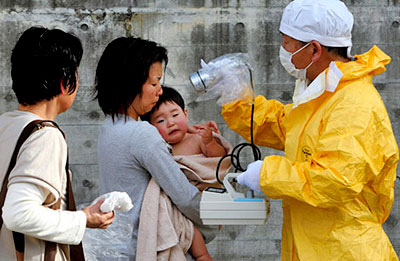|
December 20, 2011
A peer-reviewed study published in the International Journal of Health Services estimates 14,000 excess deaths in the United States are linked to the radioactive fallout from the Fukushima nuclear reactors.
The article by Joseph Mangano and Janette Sherman is the first published in a medical journal.
The authors write that that their estimate of 14,000 excess U.S. deaths in the 14 weeks following the Fukushima meltdowns is comparable to the 16,500 excess deaths in the 17 weeks after the Chernobyl meltdown in 1986.
Most of the deaths occurred among U.S. infants under age one.
The 2010-2011 increase for infant deaths
in the spring was 1.8 percent, compared to a decrease of 8.37
percent in the preceding 14 weeks, the authors note.
...according to a press release posted on December 19 by Joseph Mangano, Janette Sherman and the International Journal of Health Services.
The health impact of the radiation released from Fukushima was downplayed by the Japanese and U.S. governments.
Fukushima Reactor Disaster Fallout International Journal of Health Services December 19, 2011 from MarketWatch Website
Dec. 19, 2011 PRNewswire via COMTEX
This is the first peer-reviewed study published in a medical journal documenting the health hazards of Fukushima. Authors Joseph Mangano and Janette Sherman note that their estimate of 14,000 excess U.S. deaths in the 14 weeks after the Fukushima meltdowns is comparable to the 16,500 excess deaths in the 17 weeks after the Chernobyl meltdown in 1986.
The rise in reported deaths after Fukushima was largest among U.S. infants under age one.
The 2010-2011 increase for infant deaths in the spring was 1.8 percent, compared to a decrease of 8.37 percent in the preceding 14 weeks.
Read the IJHS article "An Unexpected Mortality Increase in The United States Follows Arrival of The Radioactive Plume from Fukushima - Is There a Correlation?".
Just six days after the disastrous meltdowns struck four reactors at Fukushima on March 11, scientists detected the plume of toxic fallout had arrived over American shores. Subsequent measurements by the U.S. Environmental Protection Agency (EPA) found levels of radiation in air, water, and milk hundreds of times above normal across the U.S.
The highest detected levels of Iodine-131 in precipitation in the U.S. were as follows (normal is about 2 picocuries I-131 per liter of water):
Epidemiologist Joseph Mangano, MPH MBA, said:
Mangano is executive director, Radiation and Public Health Project, and the author of 27 peer-reviewed medical journal articles and letters.
Internist and toxicologist Janette Sherman, MD, said:
Dr. Sherman is an adjunct professor, Western Michigan University, and contributing editor of "Chernobyl - Consequences of the Catastrophe for People and the Environment" published by the NY Academy of Sciences in 2009, and author of "Chemical Exposure and Disease and Life's Delicate Balance - Causes and Prevention of Breast Cancer."
The Centers for Disease Control and Prevention (CDC) issues weekly reports on numbers of deaths for 122 U.S. cities with a population over 100,000, or about 25-30 percent of the U.S.
In the 14 weeks after Fukushima fallout arrived in the U.S. (March 20 to June 25), deaths reported to the CDC rose 4.46 percent from the same period in 2010, compared to just 2.34 percent in the 14 weeks prior.
Estimated excess deaths during this
period for the entire U.S. are about 14,000.
A streaming audio replay of a related
news event, in below multimedia. Embargoed copies of the medical
journal article are available
here.
|


